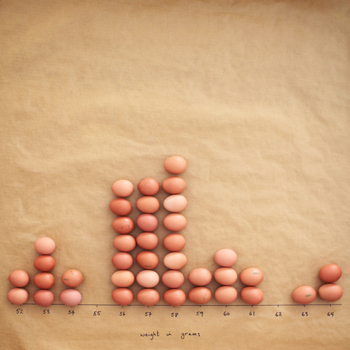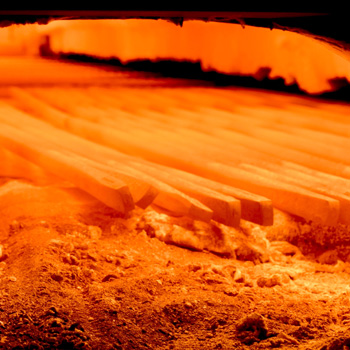
This photo by Rebecca Herbst shows natural egg variation: this sample of 40 supermarket eggs from the same brand were weighed and arranged by mass.
In a sample like this, where nature should dictate the variation in mass, we would expect to see a normal distribution that you might know as a 'bell curve'.
This is not really the case. But why do you think that is?
It could be because:

This image of a furnace is by Professor Mark McGuinness, Victoria University of Wellington, New Zealand, and is an example of how maths improved an industrial process.
According to Professor McGuinness, a manufacturer of steel coils came to the Mathematics in Industry Study Group to seek help in saving on power costs. They asked for a mathematical model of the heat lost while tempering steel rods in their gas-fired furnaces.
With calculus, computer coding and “extensive use of mathematics”, Professor McGuinness and colleagues were able to help redesign the furnace entrance.
“The manufacturer gave us a glowing reference,” he says.
These images were shared on the Academy’s social media platforms during National Science Week.
Spot the maths is a photography competition for all school aged children, from Foundation to Year 12. To enter students are asked to spot the maths, take a photo and write a short 240-character description of the maths that they spotted!
The winning photographer in each category will receive a prize pack and a prize for their whole class! Second place photographers will receive a classroom prize pack. There is also a special prize for photographs showcasing statistics.
The Australian Academy of Science’s National Committee for Mathematical Sciences is hosting scienceXart: spot the maths to recognise mathematics and its prominence in science and society. This initiative is part of the Academy’s celebration of the International Mathematical Union’s Centennial held in collaboration with and supported by the Australian Mathematical Society and the Statistical Society of Australia.
This competition has been tailored to align with Australian curriculum learning outcomes, making it a great opportunity for learning at home or as part of an in-class project. A classroom resource on how to spot maths and ideas on how to write the description can be found here.
Find out more and to submit your scienceXart: spot the maths entry.
The National Committee for Space and Radio Science provides updates about international scientific unions and committees, news from the local scientific community, and information on relevant funding opportunities, conferences and awards. Importantly, the update is providing a way to keep the community informed on the progress of the decadal plan for space science.
© 2025 Australian Academy of Science